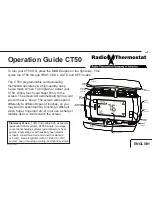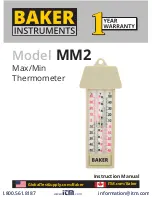
Glass Capsule Standard Platinum Resistance Thermometer
Operation
7
Comparison Calibration of Other Instruments
The uniformity and stability of the bath and the degree of accuracy required determine the number
of temperature measurements necessary. However, to follow “good” practice procedures, always
measure the triple point of water resistance (R
tpw
) after each temperature measurement. This
provides the most accurate measurement of the resistance ratio:
W(o)
=
R(o)
R
opw
Measuring Current
The recommended current for the 5686 is 1 mA for most situations. The resistance sensitivity
with temperature becomes lower at lower temperatures. To compensate for the loss of sensitivity,
measuring currents below 24.5 K are generally increased from 1 mA usually used above that
temperature, up to about 5 mA at 13.8 K.
Errors caused by self-heating of the element need to be minimized. Allowing sufficient time for
the SPRT to stabilize and the heat to be dispersed into the surrounding medium will provide the
most accurate results.
The Fluke testing or calibration certificates provided with the SPRT represent data that has been
extrapolated. For example, on Model 5686 measurements are made at 1 mA and 1.41 mA. These
measurements are then extrapolated to zero current. This can be done graphically by plotting
i² vs R and extrapolating to zero power or by using the following equation:
R
0
=R
1
-
i
1
2
(R
2
- R
1
)
i
2
2
-
i
1
2
Where:
R
0
= Zero current resistance
R
1
= Resistance measured at current i
1
R
2
= Resistance measured at current i
2
The exact immersion depth required can be determined by performing a gradient test taking
measurements approximately every 1/2 inch (1.27 cm) until there is a significant difference in
readings. Allow the thermometer to stabilize at each new depth. Plot the results to see the stem
effect.
Thermal EMF
Two factors contribute to thermal EMF, chemical consistency and physical consistency. Variations
in chemical structure due to impurities and discrepancies in crystal structure can contribute
to thermal EMF. These factors are minimized by annealing the full length of wire before
construction of the SPRT.
Likewise, connection to extension lead wires and readout instruments can be a source of thermal
EMF. The thermal EMF is caused by a difference in temperature between two connections. If
the two connections are the same temperature, there will be little or no thermal EMF effects.
However, if there is a substantial temperature difference between connections, the thermal EMF
effects will be significant. Therefore, cover or insulate any exposed bridge or galvanometer
terminals to lessen the source of error. The effects of thermal EMF can be canceled by using an ac
bridge or a dc bridge with reversible current.
Summary of Contents for 5686
Page 4: ...5686 Users Guide ii ...
Page 6: ...5686 Users Guide iv ...
Page 8: ...5686 Users Guide vi ...
Page 16: ...5686 Users Guide 8 ...


































